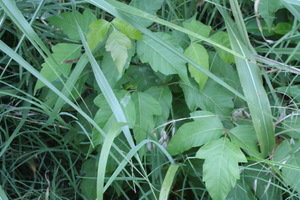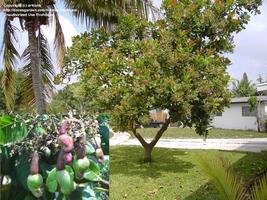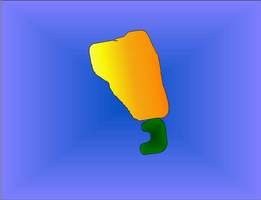





To the unsuspecting, a handful of a beautiful three leafed vine will give an unwelcome surprise; an exclusive ticket to enter Scratch City. But quite unbelievable is the fact that Poison Ivy and Cashews share an itchy chemical.
So many of us have experienced the pain and itch of Poison Ivy that even non-gardeners tend to keep a watchful eye for Poison Ivy, Poison Oak and other itchy or poisonous plants. For the most part, no one would ever consider eating any of these plants.

But most of us have enjoyed a cashew or two or two hundred and twenty two. Cashews are a favorite for many people, including my mother. Most Americans are accustomed to the roasted, toasted and salted cashews sold in the grocery stores. Health food stores sell cashews marketed as "raw". These are a light, off-white color and taste almost sweet. The majority of these "raw" cashews are not truly "raw". These cashews are processed to remove the chemical resin urushiol, which is also the chemical that is found in poison ivy and mangos. The cashew is also related to poison sumac and to pistachios.
According to Wikipedia, 32 countries of the world produce a total of 3.1 million tons of cashews a year. Also interesting is that Cashews have been used against tooth abscesses and other bacteria.1
The Cashew tree can spread as wide as a basketball court. Its botanical name is Anarcardium occidentale, and it is a subtropical (or tropical) evergreen tree that produces a false fruit. This fruit looks like a slim red or yellow basic "green pepper" like we find in the American grocery stores. This edible false fruit is called the Cashew Apple. My sister has eaten the fruit after it has been cut in strips and grilled or sautéed. She says that it tastes simply okay, like Prickly Pear Cactus leaves. Some people rave about the fruit and a juice made from it but others practically spit as they recall the taste as being "unbelievably horrible". Dave's Garden critterologist said that the fruit juice concentrate was "...absolutely foul...it tasted about the way that ginkgo fruit smells".

Special thanks to artcons from Dave'sGarden for the use of the picture on the left; a Cashew Tree/maturing false fruit and the cashews (shells). See the footnotes for a link to interesting plant files information.
The item on the right is a rendering of a mature false fruit and cashew shell.

Hanging like a worm emerging from the bottom end of an apple or like a Lima Bean hot glued to the apple, is a shell; the true fruit of the Cashew Tree. This is shaped like a very large lima or kidney bean. Inside this interesting double shell is not only the chemical urushiol but also, encased in a thin brown wrapper, is the seed: the prized and expensive cashew nut. The nut is found in the upper part of this shell (the part near the false fruit), while the lower part contains the resin. Once harvested, cashews are typically either steamed or roasted; less frequently, the cashew nuts are extracted without roasting.
The leaves of the Cashew Tree also contain urushiol according to an internet site called wisegeek. This website also notes that processed urushiol is used in other products, including in finishes, coatings and brake linings.2 Who knows; maybe urushiol contains a potent cancer fighter, too!Although anyone could be allergic to any substance, true raw cashews may cause severe, fatal allergic reactions.Of course, there are many other plants that can cause skin problems. According to Dermnetnz on-line, even Marigolds, Onions, Figs and Kiwifruit can irritate skin.3 Also, the unbelievable stinky Ginkgo biloba tree fruit produces a substance called Ginkgolic acid that irritates skin. For example, Dave's Garden member critterologist D-mailed me this comment on the article: "I had an outbreak of poison ivy rash one spring at U Chicago and was lamenting to my doc at student health how unfair it was when I hadn't even managed to 'really' get outside except to sit next to Botany Pond. A passing intern overheard and asked if I'd been sitting under the old ginkgo tree... when I said yes, she told me that decades of the fruit falling around the pond has actually built up a level of chemical in the soil there, and I'd been sitting around in shorts...
See the foot-notes for a link to a list of many irritating plants.
So, the next time that you enjoy some cashews, you can amaze your friends with your vast wisdom. But beware; I have received a few of the "crazy looks" when I mention this strange paradox between Cashews and Poison Ivy.
The moral of the story is: If you eat a truly raw cashew, it might be the last cashew you ever eat.
1 http://www.en.wikipedia.org/wiki/Cashew
2http://www.wisegeek.com/are-raw-cashews-really-poisonous.htm
3 http://www.dermnetnz.org/dermatitis/plants/
For pictures and more interesting comments from DavesGarden.com Plant files, please click here.
Copyright © www.100flowers.win Botanic Garden All Rights Reserved